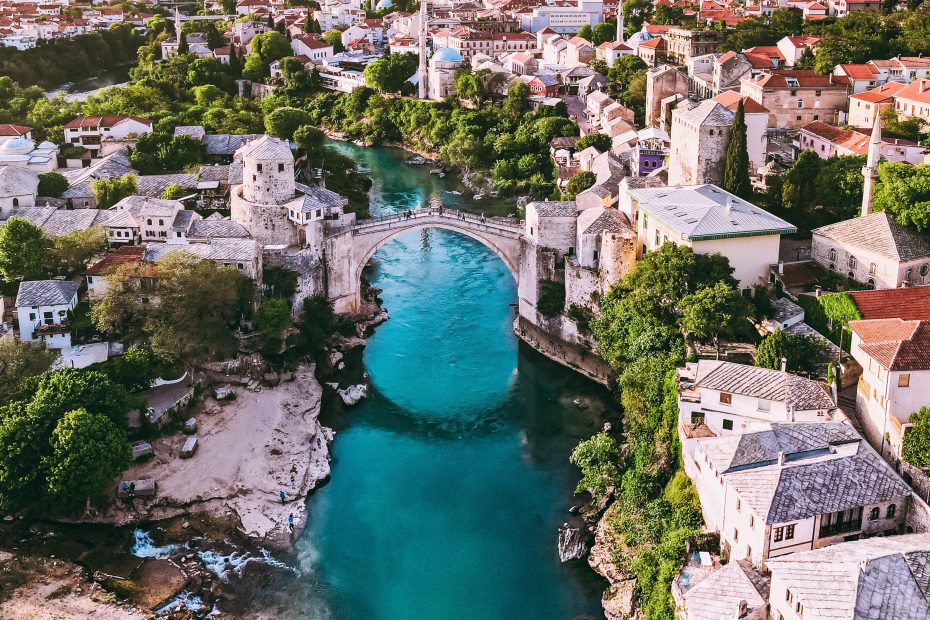Table of Contents
Introduction
Bosnia and Herzegovina is a country with a complex history and an incredibly diverse cultural heritage. Located on the Balkan peninsula in Southeastern Europe, it has been shaped over centuries by the overlapping of empires and religions. Though it experienced tragic conflict in the 1990s, Bosnia and Herzegovina has re-emerged as a nation of tremendous cultural richness. This article will highlight the many facets that make up the vibrant tapestry of Bosnian culture.
Body
Geography and Regions
Geographically diverse, Bosnia and Herzegovina features mountains, rivers, lakes, plains, and a small coastline along the Adriatic Sea. The country can be divided into three main regions: the northern Bosnian region, the central mountainous region, and the southern Herzegovina region. The diversity of the landscape contributes to cultural distinctions between these areas.
Religions
Bosnia has a long history of religious diversity. For centuries, it has been a meeting place between Christianity and Islam. According to estimates, around 45% of the population is Muslim, predominantly Sunni. Another 35% belong to the Serbian Orthodox church, with around 15% identifying as Roman Catholic. Magnificent mosques, orthodox cathedrals, Catholic churches can all be found across Bosnia and Herzegovina. These stunning religious sites are a testament to the country’s openness to varied faiths.
Ethnic Groups
Bosnia’s main ethnic groups are the Bosniaks, Serbs and Croats. The Bosniaks follow Islam and speak Bosnian. The Serbs are Orthodox and speak Serbian, while Catholic Croats speak Croatian. Despite tensions in the past, these groups share a common fondness for music, literature and cuisine across ethnic lines. Their cultural traditions all contribute to the nation’s rich heritage.
Languages
Bosnian, Croatian and Serbian are all official languages in the country. Because they are similar Slavic languages, most Bosnians can communicate with each other easily, especially in cities. However, various dialects and informal variations exist between regions, villages and ethnic groups. This linguistic diversity only adds to the cultural mosaic.
Cuisine
Given its location and multi-ethnic culture, Bosnian cuisine combines influences from Mediterranean, Slavic, Central European and Middle Eastern cooking. Grilled meats, local cheeses, breads, and vegetarian dishes like dolma demonstrate this blend. Classic Bosnian dishes include ćevapi, klepe, burek and sogan dolma. Bosnians also enjoy Turkish coffee and desserts like baklava and tufahije.
Music and Dance
Folk music traditions in Bosnia include ganga singing and instruments like the saz, accordion and šargija. The traditional kolo dance is popular across ethnic groups, and is performed at festivals and celebrations. More recent musical styles include Bosnian rock and hip-hop which fuse global pop with local influences. Overall, Bosnia boasts a sonic landscape as diverse as its people.
Art and Literature
From intricate metalwork to vivid carpet weaving, Bosnia has long been home to stunning handicrafts. Prominent artists embrace both classical and contemporary styles in their work. The country has given rise to acclaimed writers like Nobel Prize winner Ivo Andrić, Aleksandar Hemon and Semezdin Mehmedinović among others. Bosnia’s natural beauty and tumultuous history provide endless inspiration.
Festivals and Events
Throughout the year, Bosnians celebrate both religious and secular holidays. Major festivals include Ramadan Bajram, Orthodox Christmas, and Catholic New Year and Christmas. Cultural events like the Baščaršijske Noći festival in Sarajevo promote Bosnian music, crafts and cuisine. These lively gatherings highlight the hospitality and enthusiasm at the heart of Bosnian identity.
Conclusion
While enduring many hardships over its long history, Bosnia and Herzegovina has maintained and even strengthened its character as a diverse cultural mosaic. Various ethnic groups, languages, landscapes, faiths and artistic traditions coexist within its borders. Immersing oneself in the everyday life of Bosnia, one discovers the singular spirit of its people. Despite differences, Bosnians share a remarkable ability to find joy and community through culture. The nation’s kaleidoscopic heritage will hopefully continue to thrive for generations to come.
FAQs
What are the main ethnic groups in Bosnia and Herzegovina?
The three largest ethnic groups are Bosniaks (Bosnian Muslims), Serbs (Orthodox Christians), and Croats (Catholic Christians).
What languages are spoken in Bosnia?
The official languages are Bosnian, Croatian and Serbian. Most Bosnians can communicate across the languages, though regional dialects exist.
What religions are practiced in Bosnia and Herzegovina?
Around 45% of Bosnians are Muslim, 35% Orthodox Christian, and 15% Roman Catholic. Minority groups practice Judaism, Protestantism and other faiths.
What instruments are commonly used in Bosnian folk music?
Typical instruments include the saz, accordion, šargija (lute), diple (flute), and tamburica.
What are some signature Bosnian dishes and foods?
Popular cuisine includes grilled meats like ćevapi, stuffed veggies (dolma/sarma), pita (burek), Bosnian coffee, and sweets like baklava.
